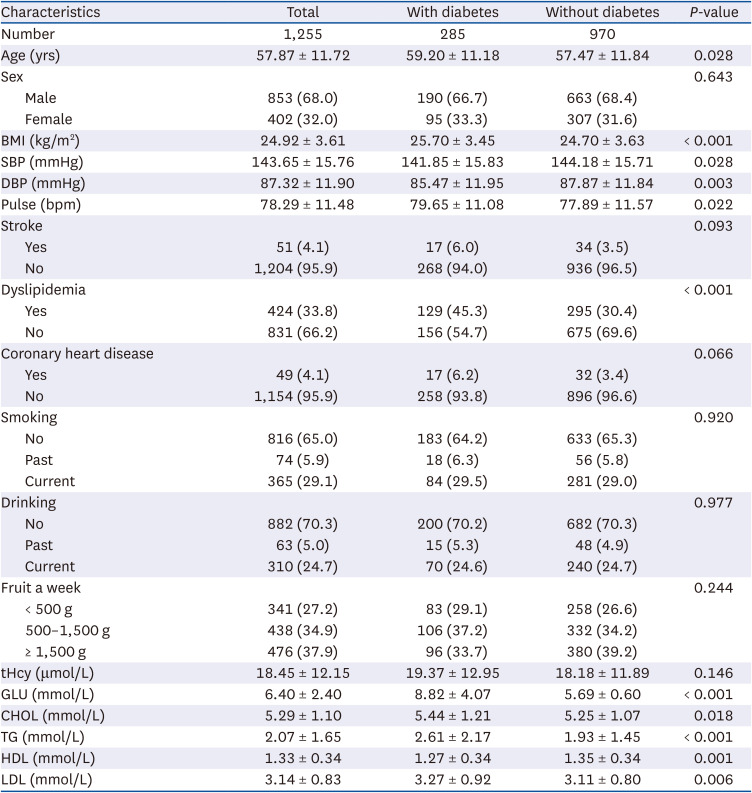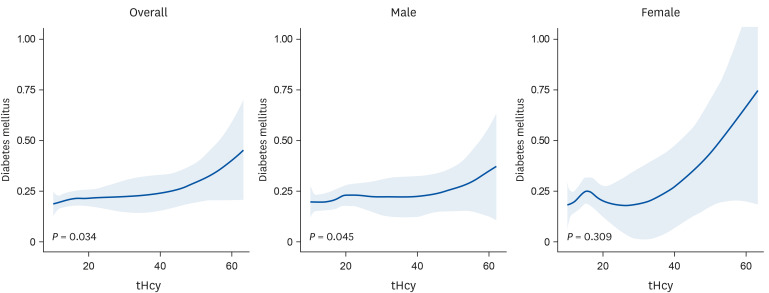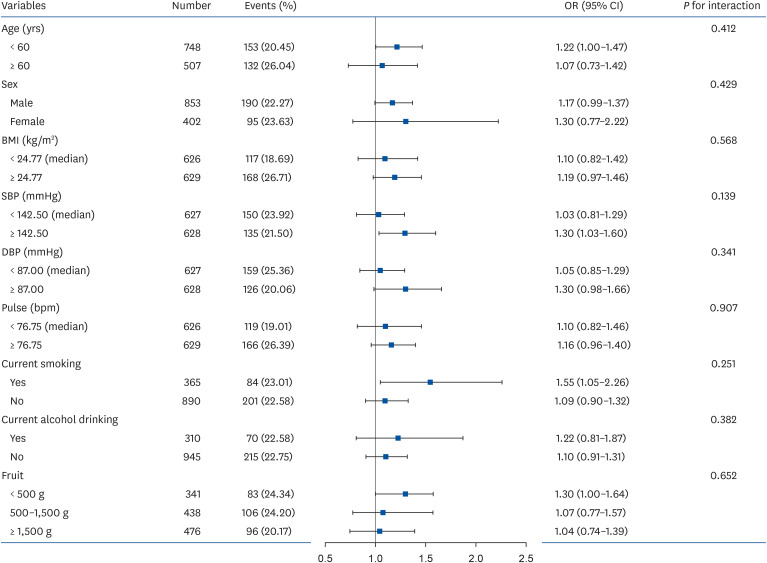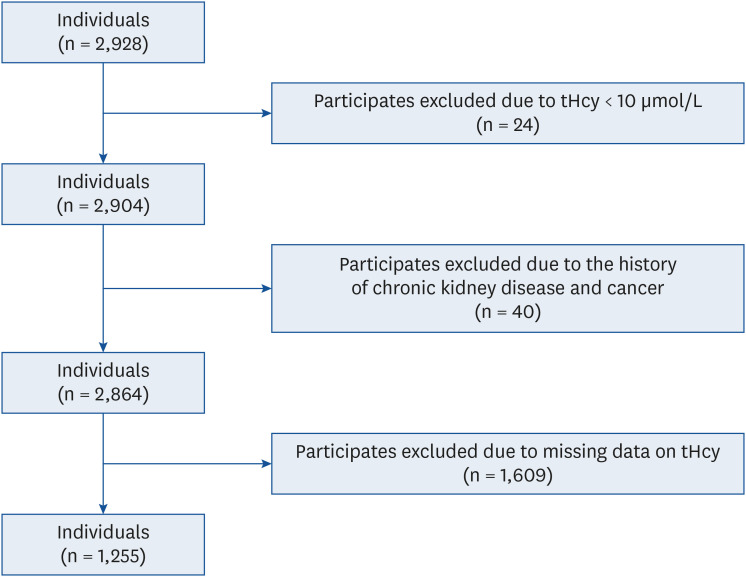1. Chatterjee S, Khunti K, Davies MJ. Type 2 diabetes. Lancet. 2017; 389:2239–2251. PMID:
28190580.

2. Boushey CJ, Beresford SA, Omenn GS, Motulsky AG. A quantitative assessment of plasma homocysteine as a risk factor for vascular disease. Probable benefits of increasing folic acid intakes. JAMA. 1995; 274:1049–1057. PMID:
7563456.

3. Verhoef P, Stampfer MJ, Buring JE, Gaziano JM, Allen RH, Stabler SP, Reynolds RD, Kok FJ, Hennekens CH, Willett WC. Homocysteine metabolism and risk of myocardial infarction: relation with vitamins B6, B12, and folate. Am J Epidemiol. 1996; 143:845–859. PMID:
8610698.
4. Emoto M, Kanda H, Shoji T, Kawagishi T, Komatsu M, Mori K, Tahara H, Ishimura E, Inaba M, Okuno Y, et al. Impact of insulin resistance and nephropathy on homocysteine in type 2 diabetes. Diabetes Care. 2001; 24:533–538. PMID:
11289481.

5. Hoogeveen EK, Kostense PJ, Beks PJ, Mackaay AJ, Jakobs C, Bouter LM, Heine RJ, Stehouwer CD. Hyperhomocysteinemia is associated with an increased risk of cardiovascular disease, especially in non-insulin-dependent diabetes mellitus: a population-based study. Arterioscler Thromb Vasc Biol. 1998; 18:133–138. PMID:
9445267.

6. Ala OA, Akintunde AA, Ikem RT, Kolawole BA, Ala OO, Adedeji TA. Association between insulin resistance and total plasma homocysteine levels in type 2 diabetes mellitus patients in south west Nigeria. Diabetes Metab Syndr. 2017; 11(Suppl 2):S803–S809. PMID:
28610915.

7. Ndrepepa G, Kastrati A, Braun S, Koch W, Kölling K, Mehilli J, Schömig A. Circulating homocysteine levels in patients with type 2 diabetes mellitus. Nutr Metab Cardiovasc Dis. 2008; 18:66–73. PMID:
17027242.

8. Passaro A, D’Elia K, Pareschi PL, Calzoni F, Carantoni M, Fellin R, Solini A. Factors influencing plasma homocysteine levels in type 2 diabetes. Diabetes Care. 2000; 23:420–421. PMID:
10868878.
9. Yu C, Wang J, Wang F, Han X, Hu H, Yuan J, Miao X, Yao P, Wei S, Wang Y, et al. Inverse association between plasma homocysteine concentrations and type 2 diabetes mellitus among a middle-aged and elderly Chinese population. Nutr Metab Cardiovasc Dis. 2018; 28:278–284. PMID:
29337020.

10. Executive summary: standards of medical care in diabetes--2010. Diabetes Care. 2010; 33(Suppl 1):S4–10. PMID:
20042774.
11. Ebesunun MO, Obajobi EO. Elevated plasma homocysteine in type 2 diabetes mellitus: a risk factor for cardiovascular diseases. Pan Afr Med J. 2012; 12:48. PMID:
22937188.
12. Yuan X, Ding S, Zhou L, Wen S, Du A, Diao J. Association between plasma homocysteine levels and pancreatic islet beta-cell function in the patients with type 2 diabetes mellitus: a cross-sectional study from China. Ann Palliat Med. 2021; 10:8169–8179. PMID:
34353101.

13. Schaffer A, Verdoia M, Barbieri L, Cassetti E, Suryapranata H, De Luca G. Impact of diabetes on homocysteine levels and its relationship with coronary artery disease: a single-centre cohort study. Ann Nutr Metab. 2016; 68:180–188. PMID:
26950830.

14. Platt DE, Hariri E, Salameh P, Merhi M, Sabbah N, Helou M, Mouzaya F, Nemer R, Al-Sarraj Y, El-Shanti H, et al. Type II diabetes mellitus and hyperhomocysteinemia: a complex interaction. Diabetol Metab Syndr. 2017; 9:19. PMID:
28331553.
15. Wang YS, Ye J, Yang X, Zhang GP, Cao YH, Zhang R, Dai W, Zhang Q. Association of retinol binding protein-4, cystatin C, homocysteine and high-sensitivity C-reactive protein levels in patients with newly diagnosed type 2 diabetes mellitus. Arch Med Sci. 2019; 15:1203–1216. PMID:
31572465.

16. Qin X, Li Y, Yuan H, Xie D, Tang G, Wang B, Wang X, Xu X, Xu X, Hou F. Relationship of MTHFR gene 677C → T polymorphism, homocysteine, and estimated glomerular filtration rate levels with the risk of new-onset diabetes. Medicine (Baltimore). 2015; 94:e563. PMID:
25700330.
17. Smulders YM, Rakic M, Slaats EH, Treskes M, Sijbrands EJ, Odekerken DA, Stehouwer CD, Silberbusch J. Fasting and post-methionine homocysteine levels in NIDDM. Determinants and correlations with retinopathy, albuminuria, and cardiovascular disease. Diabetes Care. 1999; 22:125–132. PMID:
10333913.

18. Buysschaert M, Dramais AS, Wallemacq PE, Hermans MP. Hyperhomocysteinemia in type 2 diabetes: relationship to macroangiopathy, nephropathy, and insulin resistance. Diabetes Care. 2000; 23:1816–1822. PMID:
11128359.

19. Koehler KM, Baumgartner RN, Garry PJ, Allen RH, Stabler SP, Rimm EB. Association of folate intake and serum homocysteine in elderly persons according to vitamin supplementation and alcohol use. Am J Clin Nutr. 2001; 73:628–637. PMID:
11237942.
20. Stickel F, Choi SW, Kim YI, Bagley PJ, Seitz HK, Russell RM, Selhub J, Mason JB. Effect of chronic alcohol consumption on total plasma homocysteine level in rats. Alcohol Clin Exp Res. 2000; 24:259–264. PMID:
10776661.

21. Russo GT, Di Benedetto A, Giorda C, Alessi E, Crisafulli G, Ientile R, Di Cesare E, Jacques PF, Raimondo G, Cucinotta D. Correlates of total homocysteine plasma concentration in type 2 diabetes. Eur J Clin Invest. 2004; 34:197–204. PMID:
15025678.

22. Wang B, Wu H, Li Y, Ban Q, Huang X, Chen L, Li J, Zhang Y, Cui Y, He M, et al. Effect of long-term low-dose folic acid supplementation on degree of total homocysteine-lowering: major effect modifiers. Br J Nutr. 2018; 120:1122–1130. PMID:
30401001.

23. Refsum H, Smith AD, Ueland PM, Nexo E, Clarke R, McPartlin J, Johnston C, Engbaek F, Schneede J, McPartlin C, et al. Facts and recommendations about total homocysteine determinations: an expert opinion. Clin Chem. 2004; 50:3–32. PMID:
14709635.

24. Thögersen AM, Nilsson TK, Dahlen G, Jansson JH, Boman K, Huhtasaari F, Hallmans G. Homozygosity for the C677-->T mutation of 5,10-methylenetetrahydrofolate reductase and total plasma homocyst(e)ine are not associated with greater than normal risk of a first myocardial infarction in northern Sweden. Coron Artery Dis. 2001; 12:85–90. PMID:
11281306.
25. Friedman G, Goldschmidt N, Friedlander Y, Ben-Yehuda A, Selhub J, Babaey S, Mendel M, Kidron M, Bar-On H. A common mutation A1298C in human methylenetetrahydrofolate reductase gene: association with plasma total homocysteine and folate concentrations. J Nutr. 1999; 129:1656–1661. PMID:
10460200.

26. Stampfer MJ, Grodstein F. Can homocysteine be related to physical functioning? Am J Med. 2002; 113:610–611. PMID:
12459410.

27. Han L, Liu Y, Wang C, Tang L, Feng X, Astell-Burt T, Wen Q, Duan D, Lu N, Xu G, et al. Determinants of hyperhomocysteinemia in healthy and hypertensive subjects: a population-based study and systematic review. Clin Nutr. 2017; 36:1215–1230. PMID:
27908565.

28. Challa F, Getahun T, Sileshi M, Nigassie B, Geto Z, Ashibire G, Gelibo T, Teferra S, Seifu D, Sitotaw Y, et al. Prevalence of hyperhomocysteinaemia and associated factors among Ethiopian adult population in a 2015 national survey. BioMed Res Int. 2020; 2020:9210261. PMID:
32420383.

29. Zeng Q, Li F, Xiang T, Wang W, Ma C, Yang C, Chen H, Xiang H. Influence of food groups on plasma total homocysteine for specific MTHFR C677T genotypes in Chinese population. Mol Nutr Food Res. 2017; 61:1600351. PMID:
27515258.
30. Shi C, Wang P, Airen S, Brown C, Liu Z, Townsend JH, Wang J, Jiang H. Nutritional and medical food therapies for diabetic retinopathy. Eye Vis (Lond). 2020; 7:33. PMID:
32582807.

31. Selhub J, Jacques PF, Rosenberg IH, Rogers G, Bowman BA, Gunter EW, Wright JD, Johnson CL. Serum total homocysteine concentrations in the third National Health and Nutrition Examination Survey (1991-1994): population reference ranges and contribution of vitamin status to high serum concentrations. Ann Intern Med. 1999; 131:331–339. PMID:
10475885.

32. Brattström L. Vitamins as homocysteine-lowering agents. J Nutr. 1996; 126:1276S–80S. PMID:
8642470.

33. Jacob RA, Wu MM, Henning SM, Swendseid ME. Homocysteine increases as folate decreases in plasma of healthy men during short-term dietary folate and methyl group restriction. J Nutr. 1994; 124:1072–1080. PMID:
8027858.

34. Selhub J, Jacques PF, Wilson PW, Rush D, Rosenberg IH. Vitamin status and intake as primary determinants of homocysteinemia in an elderly population. JAMA. 1993; 270:2693–2698. PMID:
8133587.
35. Aydemir O, Türkçüoğlu P, Güler M, Celiker U, Ustündağ B, Yilmaz T, Metin K. Plasma and vitreous homocysteine concentrations in patients with proliferative diabetic retinopathy. Retina. 2008; 28:741–743. PMID:
18463519.

36. Wang T, Wang Q, Wang Z, Xiao Z, Liu L. Diagnostic value of the combined measurement of serum Hcy, serum Cys C, and urinary microalbumin in type 2 diabetes mellitus with early complicating diabetic nephropathy. ISRN Endocrinol. 2013; 2013:407452. PMID:
24159393.

37. Zheng LQ, Zhang HL, Guan ZH, Hu MY, Zhang T, Ge SJ. Elevated serum homocysteine level in the development of diabetic peripheral neuropathy. Genet Mol Res. 2015; 14:15365–15375. PMID:
26634502.

38. Hermans MP, Gala JL, Buysschaert M. The MTHFR CT polymorphism confers a high risk for stroke in both homozygous and heterozygous T allele carriers with type 2 diabetes. Diabet Med. 2006; 23:529–536. PMID:
16681562.

39. Ostrakhovitch EA, Tabibzadeh S. Homocysteine and age-associated disorders. Ageing Res Rev. 2019; 49:144–164. PMID:
30391754.
40. Shin JY. Trends in the prevalence and management of diabetes in Korea: 2007-2017. Epidemiol Health. 2019; 41:e2019029. PMID:
31319658.

41. Xu R, Huang F, Wang Y, Liu Q, Lv Y, Zhang Q. Gender- and age-related differences in homocysteine concentration: a cross-sectional study of the general population of China. Sci Rep. 2020; 10:17401. PMID:
33060744.

42. Blom HJ. Determinants of plasma homocysteine. Am J Clin Nutr. 1998; 67:188–189. PMID:
9459363.

43. Choi SH, Choi-Kwon S, Kim MS, Kim JS. Poor nutrition and alcohol consumption are related to high serum homocysteine level at post-stroke. Nutr Res Pract. 2015; 9:503–510. PMID:
26425280.

44. Hornemann T. Serine deficiency causes complications in diabetes. Nature. 2023; 614:42–43.
45. Yang M, Vousden KH. Serine and one-carbon metabolism in cancer. Nat Rev Cancer. 2016; 16:650–662. PMID:
27634448.

46. Davis SR, Stacpoole PW, Williamson J, Kick LS, Quinlivan EP, Coats BS, Shane B, Bailey LB, Gregory JF 3rd. Tracer-derived total and folate-dependent homocysteine remethylation and synthesis rates in humans indicate that serine is the main one-carbon donor. Am J Physiol Endocrinol Metab. 2004; 286:E272–E279. PMID:
14559726.

47. Cole JB, Florez JC. Genetics of diabetes mellitus and diabetes complications. Nat Rev Nephrol. 2020; 16:377–390. PMID:
32398868.

48. Morrish NJ, Wang SL, Stevens LK, Fuller JH, Keen H. Mortality and causes of death in the WHO multinational study of vascular disease in diabetes. Diabetologia. 2001; 44(Suppl 2):S14–S21. PMID:
11587045.









 PDF
PDF Citation
Citation Print
Print




 XML Download
XML Download